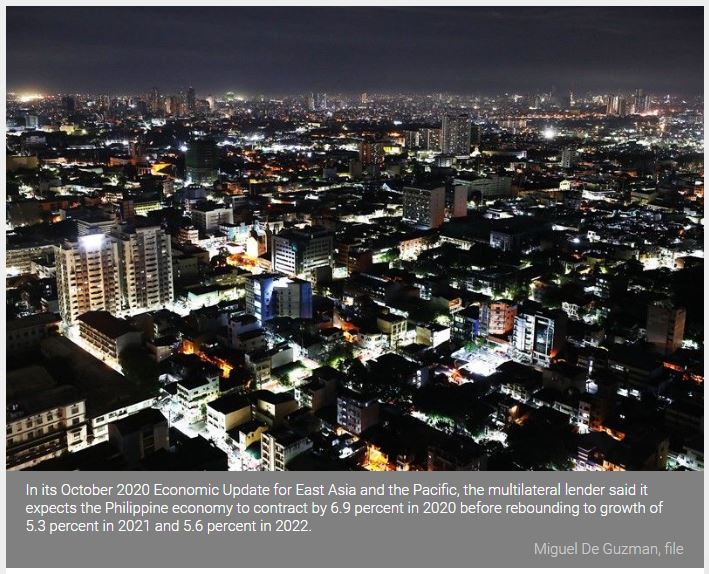Philippines: ‘Deeper slump, slower recovery’
World Bank sees worse turnout for Philippines
MANILA, Philippines — The World Bank expects a deeper economic contraction for the Philippines this year and a slower recovery by next year as the country fails to control the COVID contagion despite repeated lockdowns.
In its October 2020 Economic Update for East Asia and the Pacific, the multilateral lender said it expects the Philippine economy to contract by 6.9 percent in 2020 before rebounding to growth of 5.3 percent in 2021 and 5.6 percent in 2022.
This compares with the June forecast of a contraction of 1.9 percent this year and expectations of a faster rebound of 6.2 percent in 2021 and 7.2 percent in 2022.
Based on recent developments, the World Bank said recovery would be “a drawn out process that could slow the country’s rapid progress in poverty reduction in recent years.”
The country has so far gone on a cycle of repeated lockdowns and reopening of the economy in an effort to contain the spread of the coronavirus, the latest being the two-week reimposition of a severe community quarantine in Metro Manila and other growth areas of Bulacan, Cavite, Laguna and Rizal after exhausted medical frontliners called for a “timeout.”
The number of confirmed cases, however continued to rise and is now in the 300,000 mark.
The economy also faces harsh global headwinds because of its exposure to the global economy though trade, tourism and remittances.
Lockdowns cause severe damage to the economy because of a large population of workers at the informal sector who are steeped in poor living conditions.
“Philippines’ recovery is expected to be slower because of the failure to contain the virus and also because of the exposure to the global economy via tourism, trade and remittances,” said Aaditya Mattoo, World Bank’s chief economist for East Asia and the Pacific.
Half a year into the pandemic, recovery will now require strong social protection measures that will put cash in the pockets of the poor to support the survival of small businesses in communities.
This should go alongside the resumption of investments on human capital and infrastructure that drove the domestic economy before the pandemic.
“In the short term, every peso put directly in the hands of poor and vulnerable families through social assistance translates into demand for basic goods and services in local communities, which in turn supports micro and small enterprises and the government’s recovery efforts,” said Ndiamé Diop, World Bank country director for Philippines.
“At the same time, one cannot overemphasize the importance of improvements in public health management including testing, tracing, isolating, and treatment to effectively control the spread of COVID-19 and secure a definitive recovery.”
Diop recognized, however, that this would be challenging without the necessary infrastructure for social services such as a foundational identification, digital mobile access, and transaction accounts.
As such, investments in these would be crucial to ensure that social protection measures will reach the poor when they need it.
In a separate briefing yesterday, Interior Undersecretary Jonathan Malaya said the pre-registration process for the National ID System would proceed this year in priority provinces with low transmission of the virus to cover five million household heads.
In the first semester, the economy shrank by nine percent, the largest contraction since 1985, because mobility restrictions that closed 75 percent of the economy during the second quarter.
Exports and imports also weakened as international trade slumped, upended by massive disruptions in global value chains.
World bank senior economist Rong Qian said the the recovery forecasts for 2021 and 2022 are anchored on the assumption that transmission of the virus is managed and that there will be no major spikes in cases that will lead to further lockdowns.
Under this assumption, businesses and households will regain confidence alongside the continued rollout of the government’s infrastructure program.
Qian noted that the latest assumption still does not take into consideration the availability of a vaccine against COVID-19 but noted that recovery will be faster if it does become available sooner.
“In our baseline assumption, we assume that the economy will gradually recover and there will not be another reversal to the strict lockdown but still because of the loss of jobs and income experienced, the recovery will be very slow. But if the vaccine is available early next year then the recovery process will be accelerated,” she said.
Base effects will prop up growth in 2021 while election-related spending will boost economic activity in the latter half of 2021 throughout 2022.
“Accelerating structural reforms to improve the business environment, foster competition, and boost productivity growth can enhance inclusive growth,” said Qian.
These include reforms in sectors that are still protected like finance, transport, and communications.
“This will equip people and the private sector to take advantage of emerging digital opportunities,” she said.
Source: https://www.philstar.com/business/2020/09/30/2046024/deeper-slump-slower-recovery


 Thailand
Thailand




